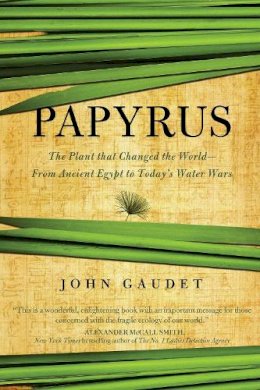32%OFF

Stock image for illustration purposes only - book cover, edition or condition may vary.
Papyrus: The Plant that Changed the World: From Ancient Egypt to Today´s Water Wars
John Gaudet
€ 16.99
€ 11.61
FREE Delivery in Ireland
Description for Papyrus: The Plant that Changed the World: From Ancient Egypt to Today´s Water Wars
Paperback. Num Pages: 272 pages, illustrations. BIC Classification: JFC; PST. Category: (P) Professional & Vocational. Dimension: 145 x 223 x 23. Weight in Grams: 340.
From ancient Pharaohs to 21st Century water wars, papyrus is a unique plant that is now the fastest growing plant species on earth. It produces its own “soil”—a peaty, matrix that floats on water—and inspired the fluted columns of the ancient Greeks. In ancient Egypt, the papyrus bounty from the Nile delta provided not just paper for record keeping—instrumental to the development of civilization—but food, fuel and boats. Disastrous weather in the 6th Century caused famines and plagues that almost to wipe out civilization in the west, but it was papyrus to the rescue. Today, it is not just a ... Read more
From ancient Pharaohs to 21st Century water wars, papyrus is a unique plant that is now the fastest growing plant species on earth. It produces its own “soil”—a peaty, matrix that floats on water—and inspired the fluted columns of the ancient Greeks. In ancient Egypt, the papyrus bounty from the Nile delta provided not just paper for record keeping—instrumental to the development of civilization—but food, fuel and boats. Disastrous weather in the 6th Century caused famines and plagues that almost to wipe out civilization in the west, but it was papyrus to the rescue. Today, it is not just a ... Read more
Product Details
Publisher
Pegasus Books
Format
Paperback
Publication date
2015
Condition
New
Number of Pages
272
Place of Publication
New York, United States
ISBN
9781605988283
SKU
V9781605988283
Shipping Time
Usually ships in 4 to 8 working days
Ref
99-8
About John Gaudet
John Gaudet, a professional ecologist has worked with the U.S. government and carried out research under grants from the National Geographic Society. As an ecologist and primary environmental advisor he is now a writer and consultant. His work has appeared in the Washington Post and he remains active in African, agricultural, and conservation/environmental agencies. John lives in northern Virginia. Visit ... Read more
Reviews for Papyrus: The Plant that Changed the World: From Ancient Egypt to Today´s Water Wars
“This fascinating and beautifully written book is an absolute eye opener into the extraordinary world of papyrus. John Gaudet has a remarkable story to tell, and he tells it extremely well. This is a wonderful, enlightening book with an important message for those concerned with the fragile ecology of our world.”
Alexander McCall Smith, bestselling author of the No. ... Read more
Alexander McCall Smith, bestselling author of the No. ... Read more
